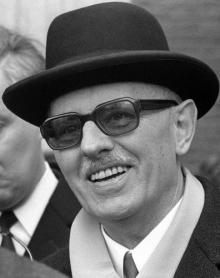Reinhard Gehlen
Contemporaries described Schnez as an energetic organizer, but also self-confident and aloof. He maintained contacts with the League of German Youth and its specialized organization, the Technischer Dienst (Technical Service), which were preparing themselves for a partisan war against the Soviets. The two groups, secretly funded by the United States, included former Nazi officers as members, and were both banned by the West German federal government in 1953 as extreme-right organizations. Schnez, it seems, had no qualms whatsoever associating himself with former Nazis.
Schnez also maintained a self-described intelligence apparatus that evaluated candidates for the “Insurance Company,” as he referred to the project, and determined if they had suspicious qualities. A criminal named K. was described as “intelligent, young and half-Jewish.”
US documents viewed by SPIEGEL indicate that Schnez negotiated with former SS Obersturmbannführer Otto Skorzeny. The SS officer became a Nazi hero during World War II after he carried out a successful mission to free deposed Italian dictator Benito Mussolini, who had been arrested by the Italian king. The former SS man had pursued plans similar to those of Schnez. In February 1951, the two agreed to “cooperate immediately in the Swabia region.” It is still unknown today what precisely became of that deal.
In his search for financing for a full-time operation, Schnez requested help from the West German secret service during the summer of 1951. During a July 24, 1951 meeting, Schnez offered the services of his shadow army to Gehlen, the head of the intelligence service, for “military use” or “simply as a potential force,” be it for a German exile government or the Western allies.
A notation in papers from the Gehlen Organization states that there had “long been relations of a friendly nature” between Schnez and Reinhard Gehlen. The documents also indicate that the secret service first became aware of the clandestine force during the spring of 1951. The Gehlen Organization classified Schnez as a “special connection” with the unattractive code name “Schnepfe,” German for “snipe”.
Did Adenauer Shy Away?
It’s likely that Gehlens’ enthusiasm for Schnez’s offer would have been greater if had it come one year earlier, when the Korean War was breaking out. At the time, the West German capital city of Bonn and Washington had considered the idea of “gathering members of former German elite divisions in the event of a catastrophe, arming and then assigning them to Allied defense troops.”
Within a year, the situation had defused somewhat, and Adenauer had retreated from this idea. Instead, he pushed for West Germany to integrate more deeply with the West and for the establishment of the Bundeswehr. Schnez’s illegal group had the potential to threaten that policy — if its existence had become public knowledge, it could have spiraled into an international scandal.
Still, Adenauer decided not to take action against Schnez’s organization — which raises several questions: Was he shying away from a conflict with veterans of the Wehrmacht and the Waffen-SS?
There were misgivings within the Gehlen Organization, particularly surrounding Skorzeny. According to another BND document seen by SPIEGEL, a division head raised the question of whether it was possible for the organization to take an aggressive stance against Skorzeny. The Gehlen Organization man suggested consulting “the SS”, adding, the SS “is a factor and we should sound out opinions in detail there before making a decision.” Apparently networks of old and former Nazis still exercised considerable influence during the 1950s.
It also became clear in 1951 that years would pass before the Bundeswehr could be established. From Adenauer’s perspective, this meant that, for the time being, the loyalty of Schnez and his comrades should be secured for the event of a worst-case scenario. That’s probably why Gehlen was assigned by the Chancellery “to look after and to monitor the group.”
It appears Konrad Adenauer informed both his American allies as well as the political opposition of the plan at the time. The papers seem to indicate that Carlo Schmid, at the time a member of the SPD’s national executive committee, was “in the loop.”
Little Known about Disbanding of Army
From that point on, Gehlen’s staff had frequent contact with Schnez. Gehlen and Schnez also reached an agreement to share intelligence derived from spying efforts. Schnez boasted of having a “particularly well-organized” intelligence apparatus.
From that point on, the Gehlen Organization became the recipient of alert lists including the names of former German soldiers who had allegedly behaved in an “undignified” manner as Soviet prisoners of war, the insinuation being that the men had defected to support the Soviet Union. In other instances, they reported “people suspected of being communists in the Stuttgart area.”
But Schnez never got showered with the money he had hoped for. Gehlen only allowed him to receive small sums, which dried up during the autumn of 1953. Two years later, the Bundeswehr swore in its first 101 volunteers. With the rearmament of West Germany, Schnez’s force became redundant.
It is currently unknown exactly when the secret army disbanded, as no fuss was made at the time. Schnez died in 2007 without ever stating anything publicly about these events. His records on the “Insurance Company” have disappeared. What is known stems largely from documents relating to the Gehlen Organization that made their way into the classified archive of its successor, the BND.
It appears they were deliberately filed there under the misleading title “insurances” in the hope that no one would ever find any reason to take interest in them.
